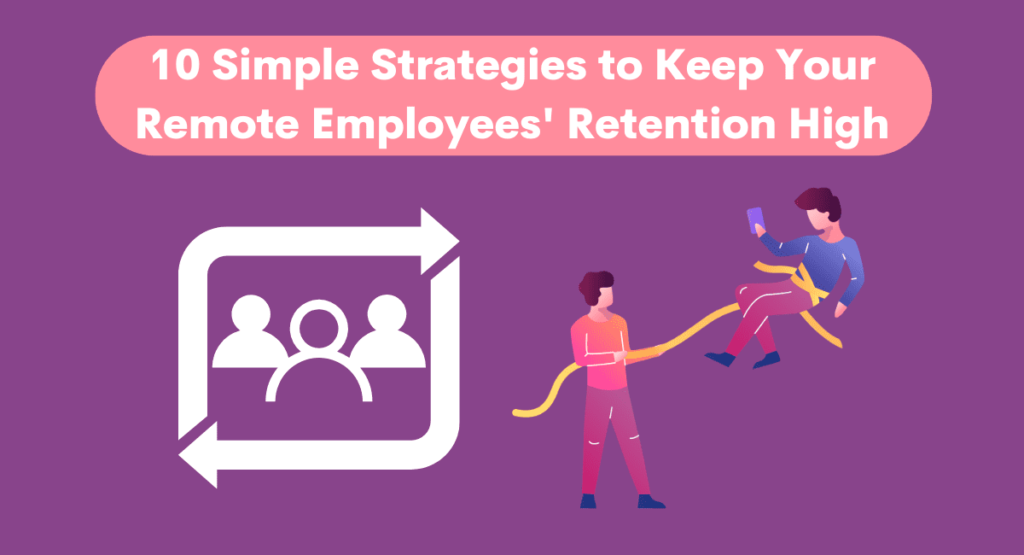10 Simple Strategies to Keep Your Remote Employees’ Retention High


Remote working from anywhere has many benefits, but staying engaged and motivated can also be challenging when you’re not in an office setting.
Finding ways to keep your remote employees happy and productive is essential, or they may become disengaged and start looking for other opportunities.
We will discuss ten simple strategies that you can use to keep your remote employees engaged and loyal!
Understand the benefits of working remotely.
“Pay is the primary reason professionals seek new opportunities. The data suggest we also need to attend to developing stronger workplace philosophies around remote work and flexible schedules.” Dr. Karen Stout.
Employees’ sense of freedom and control when they can work from anywhere or at home is a significant factor in employees’ decision to stay with their company. Remote employees could have a closer relationship with the work they do. The connection makes it easier for them to focus and motivate your work.
There is a strong relationship between employee retention and employee satisfaction. Employees who are satisfied with their jobs are less likely to leave, while employees who are unhappy with their jobs are more likely to leave.
Employees who are engaged with their work and feel valued are more likely to stay with their company, while employees who feel undervalued or unsupported are more likely to find a new job.
Why are employee retention rates so important?

Employee retention rates are important because they measure how happy employees are with their current jobs. When employee retention rates are high, employees are satisfied with their jobs and likely to stay with the company for a long time. High retention rates save the company time and money from recruiting and training new employees.
In addition, high employee retention rates also reflect well on the company’s workplace culture and may even attract new talent.
Employee retention is crucial because they show employees’ loyalty to their company. It’s good for employees and the company if they are happy with their jobs. This way, they are more likely to stay around and help the company.
Employers with a poor track record of retaining employees may have difficulty attracting top talent. So keeping employee retention rates high should be a top priority for any business!
Engage employees with regular communication.
When there is high turnover in a workplace, it can lead to a decrease in productivity and morale. It can also cost more money to replace employees than if the turnover rate were lower.
Open communication is a great way to retain employees. This way, employees know what is going on and feel appreciated.
Regular check-ins, one-on-one and in group settings, can help foster a sense of connection and belonging. Additionally, setting clear expectations and providing feedback regularly can help employees feel valued and motivated.
When employees feel that they are part of a team and that their contributions are recognized, they are likelier to stick around. By investing in regular communication, businesses can set themselves up for success by ensuring their employees feel engaged and supported.
Encourage creativity and innovation.
A company that encourages creativity and innovation will likely retain employees and attract new talent. By encouraging creativity, companies foster an environment where employees feel like their opinions are valued and that employees can make a real contribution to the company.
This ownership and pride increase productivity, morale, and retention rates. In addition, encouraging creativity helps to attract new talent, as potential employees are looking for an environment where they can exercise their creative muscles. As a result, Encouraging creativity is a win-win for employers and employees.
Make sure the work is exciting and challenging.

As an employee, you always want to ensure the work is exciting and challenging. After all, professional development is vital for keeping your skills sharp and advancing your career.
But what happens when the work starts to feel a little too familiar? It can be challenging to stay engaged and motivated when going through the motions daily. If this sounds familiar, there are a few things you can do to mix things up.
First, take on new assignments and projects. A new project will allow you to stretch your skills and learn something new.
Second, don’t be afraid to voice your opinion about what’s happening at work. Always try to contribute your knowledge to the team and suggest how remote employees can improve things.
Finally, make time for socializing and networking. Spending time with your coworkers can help remote employees form bonds that make going to work more enjoyable.
Set expectations and create a work schedule.
Company culture and employee turnover are two essential topics in the business world. A company’s culture is the personality of the company and is reflected in how it operates. Company culture can be a powerful tool to attract and retain employees.
Company retention is the process of keeping employees with a company. A company can use company culture to boost employee retention. Employees can use company culture to set expectations and create a work schedule.
Setting expectations helps employees know what target they have and helps to create a work schedule that boosts company retention. Creating a work schedule that is flexible and allows for some autonomy can help employees feel like they can balance their work and life commitments.
Allowing some flexibility in the work schedule can also help employees feel like they can have a life outside of work. Company culture can be a powerful tool to boost employee retention.
Provide regular feedback
Employees need feedback to know how they are doing. Managers need to provide feedback regularly, both positive and negative. Feedback should be given promptly, preferably immediately after the task is completed. Feedback should also be specific rather than general.
Encourage employee input.
Remote employees may feel isolated and disconnected from the rest of the team. Encouraging employee input can help to combat this feeling and keep them engaged. Ask remote employees for their opinion on projects and allow them to contribute their ideas.
Make sure remote employees feel included.
Remote employees can still participate in company events and meetings. This way, they can stay updated and connected with what is happening.
Make an effort to include remote employees in company-wide activities. The remote employee can participate through video conferencing or by sending meeting minutes and other important updates.
Provide training and development opportunities.
Remote employees may not access the same training and development opportunities as on-site employees. Providing these opportunities can help keep them engaged and motivated. Offer various training options, both online and in-person, that are relevant to their job duties.
Stay connected.
By staying connected with employees, it is easier to ensure they are always aware of what is happening with the company and their work. Check-in with them regularly, even if there is nothing new to report.
Let them know what is going on at the company and ask for their input on plans. Taking the time to stay connected will help build trust and ensure remote employees feel like part of the team.
Employee retention strategies

Employee retention is the key to the success of any organization. When employees feel appreciated and valued, they are more likely to stay with the company. Here are ten successful employee retention programs to keep your remote employees’ retention high:
1. Show appreciation
Thanking employees for their hard work is one of the simplest but most effective ways to show that you appreciate them. Send thank-you emails, give recognition in team meetings, or even offer rewards such as gift cards or bonuses.
2. Offer flexible working arrangements.
Allowing employees to have flexible hours can make them feel valued and appreciated. It also helps to improve work-life balance, leading to higher employee satisfaction and lower attrition rates.
3. Celebrate successes
Sharing success stories with your team is a great way to show appreciation and build team morale. Celebrate successes by sending out a congratulatory email, having a team lunch, or simply clapping and cheering when someone does a great job.
4. Stay connected
Staying connected with employees even when they are not in the office can help reduce attrition rates. Ensure you have a system for sending out important updates, asking for feedback and providing support when needed.
5. Encourage employee growth and development.
Helping employees grow and develop their skills is another way of showing appreciation and value. Offer training and development opportunities, encourage employees to take on new challenges and give feedback that will help them improve their skills.
6. Keep them in the loop.
Make sure remote employees feel like they are a part of the team by regularly communicating with them. Send out company-wide emails, update them on project progress, and let them know when there are changes or new developments.
7. Give them a sense of ownership.
Encouraging remote employees to take ownership of their job and giving them the freedom to make decisions. A sense of taking ownership will help them feel more invested in their work and connected to the company.
8. Stay connected with face-to-face video chats.
While remote employees don’t need to be in the office all the time, it’s essential to stay connected with them through regular video chats. Regular video meetings will help build trust and ensure everyone is on the same page.
9. Offer incentives.
Give remote employees something to look forward to by offering incentives for a job well done. The reward could be anything from a gift card to extra time off after completing a project.
10. Encourage creativity and independence.
Remote employees often have great ideas but may not always feel comfortable sharing them for fear of sounding foolish. Encourage creativity and independence by giving remote employees the freedom to explore new ideas and be themselves.
Keeping remote employees engaged and loyal can be challenging, but it’s not impossible.
Employee social media can be part of employee retention strategies. By providing employees with a way to connect online, you are giving them a way to build relationships with their coworkers. Social Media connections can help create a sense of community and belonging, leading to higher employee retention rates.
A few things employers can do to maximize remote employee retention using social media:
1. Make sure employees have access to company social media accounts. The access will allow remote employees to see what is happening at the company and connect with coworkers.
2. Use social media to share success stories and celebrate successes. Sharing success will help build team morale and show remote employees that they are part of the team.
3. Stay connected with remote employees through social media. Check in with them regularly, post updates, and ask for their input on plans. Social media relationships will help reduce attrition rates and keep remote employees engaged.
4. Encourage remote employees to connect with coworkers on social media. The connection will help them build relationships with coworkers and feel more connected to the company.
What are some common challenges remote teams face?
Remote work is a growing trend, and as such, there are often many challenges that remote teams face. These include issues with communication, trust, and motivation.
Communication
Managing remote teams can be difficult because employees aren’t able to communicate with one another face-to-face easily.
Coordination
When remote employees work on different parts of a project, it cannot be easy to coordinate their efforts and ensure everyone is on the same page.
Motivation
Motivating remote employees can be more challenging than those in the office. The reason because due to the lack of face time and/or team camaraderie.
Attention span
Since coworkers do not constantly surround remote employees, they may have difficulty staying focused and on task. Once we can help with these issues, you can improve the remote employees’ retention.
Conclusion
Supporting remote employees as a team is essential if you want to keep your remote employees engaged and productive.
Make sure that the employees working on the project have everything they need to be successful. This includes things like having the right tools and resources.
Showing you care about their well-being will help keep them happy and loyal!


